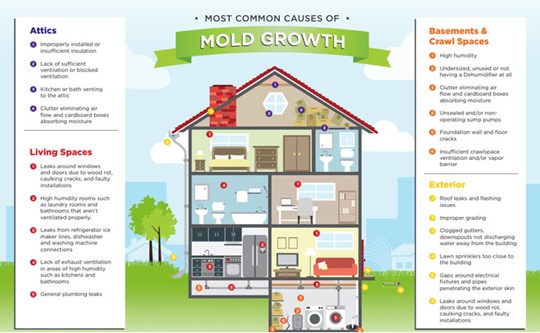Signs of Mold in Your Home and what Causes It
Even the cleanest house can harbor mold, and it can be found anywhere inside of the home. Mold can appear on any surface, from wood and paper to carpet and upholstery. When mold is present inside of a home, it releases tiny spores that float through the air. Left untreated, these spores become more mold, and colonies of mold can multiply quickly.

While this does sound scary, the professionals at Green Home Solutions are ready to help with mold remediation services . Give us a call if you notice any of the following signs of mold in your home:
- You can see it: Even a small patch of mold on walls, ceilings, or floors can indicate a larger problem. Because mold feeds on organic or porous substances and can grow on the cellulose component of drywall and wood, it often lurks inside walls or ducting, in crawl spaces, and even underneath a structure where you can’t actually see it.
- You can smell it: A musty, stale odor is often strong evidence that mold exists somewhere in your property. The hidden source of the odor must be found and identified so that it can be thoroughly eliminated.
- You can feel it: Exposure to mold can cause mildly annoying symptoms in some people, while others may experience symptoms that compromise their well-being, depending on the person’s susceptibility to mold’s toxicity.
Causes of Mold in the Attic
One of the leading causes of household mold is from poorly or incorrectly insulated attics. Poor insulation leads to temperature swings that can cause moisture to develop in the attic space over time. Mold uses the insulation as a food source and grows, thanks to constant moisture. Other factors that can cause mold growth in an attic include improperly installed or insufficient insulation, lack of sufficient ventilation, blocked insulation, a kitchen or bathroom venting to the attic, clutter that eliminates air flow, and cardboard boxes that absorb moisture.
Contact Us for Crawl Space Encapsulation and More
Green Home Solutions is your go-to resource for indoor air quality services. Alongside crawl space encapsulation, we offer a full range of services to detect and resolve environmental concerns. From mold and radon testing to moisture control and odor removal, we are committed to creating safer, cleaner homes
Talk to an expert! 1-800-SOLUTIONS
Causes of Mold in Basements and Crawl Spaces
Basements and crawl spaces have all of the right conditions for mold, so it’s very important to control moisture with a good dehumidifier year-round. In addition to moisture control, keep an eye out for places water can enter your home, and try to keep clutter to a minimum where possible. Here are our top checklist items for mold causes when we do a visual assessment:
- High humidity
- Dirt/unfinished floor
- Undersized, unused, or no dehumidifier at all
- Clutter that eliminates air flow
- Cardboard boxes that absorb moisture
- Unsealed or non-operating sump pumps
- Off-gassing from new construction materials
- Foundation wall and floor cracks that leak after storms
- Insufficient crawl space ventilation or vapor barrier
Causes of Mold in Living Spaces
Living spaces such as bedrooms, living rooms, kitchens, and especially laundry rooms and bathrooms can all support mold growth. Be on the lookout for signs of mold from issues like:
- Leaks around windows and doors due to wood rot, caulking cracks, and faulty installations
- High-humidity rooms such as laundry rooms and bathrooms that aren’t ventilated properly
- Leaks from refrigerator ice maker lines and dishwasher and washing machine connections
- Lack of exhaust ventilation in areas of high humidity such as kitchens and bathrooms
- General plumbing leaks
Exterior Causes of Mold
You may not think about it very often, but the exterior of your home is something you should check out a couple of times each year. Looking for signs of water damage and anything else from the list below can help you take control of a mold issue fast:
- Roof leaks and flashing issues
- Improper grading
- Clogged gutters and downspouts not discharging water away from the building
- Lawn sprinklers too close to the building
- Gaps around electrical fixtures and pipes penetrating the exterior skin
- Leaks around windows and doors due to wood rot, caulking cracks, and faulty installations
Any of the factors above can lead to your house becoming a home for mold too. Take a few minutes to look for these conditions in key areas in your house. We recommend examining your home’s basement, exterior, and attic at least once a year to look for new issues that may have been caused by weather.
Get a Service Quote or Request More Information
If you suspect you have an issue from the list above or you have observed any of the sight, smell, or feel signs of mold, call us to talk to a professional about getting a visual mold assessment or air quality test today! Call Green Home Solutions at 1-800-SOLUTIONS or complete the information request form.
